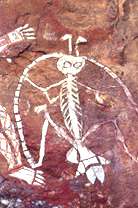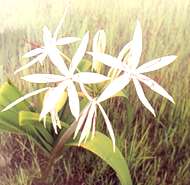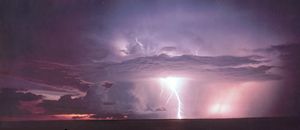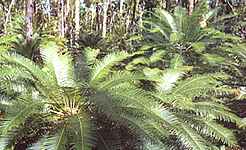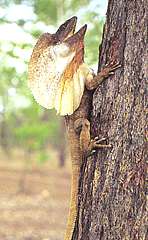Each month we bring you scenes and description from
western Arnhem Land or other parts of the Top End - showing the country,
bush food, and other aspects of Aboriginal life. On this page you
can visit:
The main photographs and text are by Wayne Miles, an outstanding
photographer from Darwin.
November - Thunder and Lightning in western Arnhem
Land
Sheltered amongst the sandstone caves of Nourlangie
Rockin Kakadu National park, known as "Burrungguy"
to Aboriginal people, are the ancient art sites of the Gagadju.
Here the rock paintings tell the story of the fiery Dreamtime
spirit who lives high in the clouds, "Namarrkon"
the lightning man. Arched across Namarrkon's shoulders are
the lightning bolts with which he opens the skies and slashes
the earth. Growing from his elbows and knees are the stone
axes with which he creates the thunder that announces to
the Gagadju the birth of another seasonal cycle called Gunumeleng.
|
|
|
|
This is the time of the pre-monsoon, when
massive cumulus cloud towers and oppressive heat is giving
way to electrifying skyscapes and the fast moving easterly
storms of the afternoon. Swollen black fronts release early
rains, lightning and violent winds. Once again the land
will waken from browns to greens, the monsoons are in the
skies. |
Following the first rains, the lily-like herb Onion Lily
sprouts throughout the coastal floodplains and the open
forests of Kakadu National Park. This sweetly scented
lily is considered to be "strong" bush medicine by the
tribes of northern Australia. Once collected, its large
onion-like tuber is chopped, crushed finely, then soaked
in water for 24 hours. With the flesh removed, the remaining
liquid is used as an external wash for the treatment of
infected and inflamed skin sores and is considered particularly
effective.
December - Pre-monsoon on the Tiwi Islands
Awe inspiring displays of lightning occur right across the
Top End during December, accompanied by deafening thunder, violent
gusts of wind, rapid downpourings of rain - signs of energy
and violence in the atmosphere.
Scorched and blackened by the sweeping fires of the hot dry
season, only one month earlier, the ancient cycads and the surrounding
tropical wood land habitat, now respond to the pre-monsoonal
rains vigorously producing new vibrant green foliage.
|
It is pre-monsoon time, the season
of "greening". With new growth, there will be new seeds
and a replenishing of bush tucker. The seeds produced
by the female cycad in the drier months (April-September),
has in the past been a source of carbohydrates for the
Aboriginal peoples of the north. |
|
Although highly toxic in their raw state, when the seeds are
roasted, peeled, soaked then ground into flour they can then
be baked into highly edible bread like cakes. Processed like
this they could be stored for lengthy periods and were especially
useful during long ceremonies.
|
Out of sight for the majority of both the wet and dry
seasons, the first rains see the Frilled Neck Lizard fossicking
the new carpet of green shoots in search of termites and
small invertebrates.
Descending from the treetops, the male dragons assume
their breeding colours in their fight for territorial
rights, their sights firmly fixed on the females in their
chosen territory. Melville Islanders say all animals in
this country have a story. They say, "this little fella
raises up his frill and opens his mouth wide when `em
in trouble, real tough little fella for his size". |
|
Text copyright Wayne Miles 1999
Back
to Seasonal calendar entry page
|





